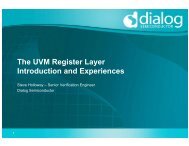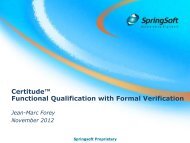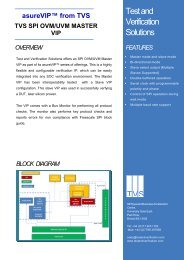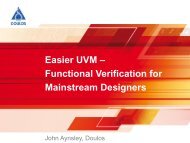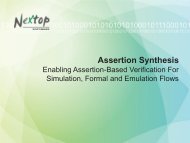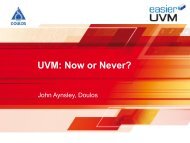Solving Chip-Level Verification Challenges - Test and Verification ...
Solving Chip-Level Verification Challenges - Test and Verification ...
Solving Chip-Level Verification Challenges - Test and Verification ...
You also want an ePaper? Increase the reach of your titles
YUMPU automatically turns print PDFs into web optimized ePapers that Google loves.
<strong>Solving</strong> <strong>Chip</strong>-<strong>Level</strong><br />
<strong>Verification</strong> <strong>Challenges</strong><br />
Balaji Kaliraj<br />
Lavanya Rekha<br />
Broadcom Corporation<br />
Broadcom Proprietary <strong>and</strong> Confidential. © 2013 Broadcom Corporation. All rights reserved.
Overview<br />
• Gate-level simulations<br />
– <strong>Challenges</strong> seen<br />
– <strong>Test</strong> bench configurations<br />
– Simulation time<br />
– Timing closed PD blocks<br />
– Statistics<br />
• The Package-Aware <strong>Test</strong> Bench (PAT)<br />
– <strong>Chip</strong>-Aware <strong>and</strong> Package-Aware <strong>Test</strong> Benches<br />
– The need for PAT<br />
– Methodology<br />
– Advantages<br />
2
Gate-<strong>Level</strong> Simulations<br />
• RTL simulations verify the functionality of the design.<br />
• To verify interface timing across modules, gate-level<br />
simulations are required.<br />
• Timing at clock domain crossings is verified.<br />
• St<strong>and</strong>ard Delay Format (SDF) annotated netlist is<br />
used instead of RTL.<br />
<strong>Test</strong> Bench<br />
<strong>Chip</strong> RTL<br />
<strong>Chip</strong><br />
netlist<br />
with SDF<br />
3
<strong>Challenges</strong><br />
• The design is huge.<br />
• The tool may crash while trying to load the entire<br />
SDF annotated design.<br />
• Running the simulation with the complete netlist is<br />
practically impossible.<br />
• Simulation on full chip test bench<br />
takes approximately 40 CPS.<br />
4
<strong>Test</strong> Bench Configurations<br />
• These challenges are solved by having different<br />
flavors of test benches on which to run the gatesims.<br />
• The design is functionally partitioned, with a netlist<br />
for blocks of interest <strong>and</strong> black-boxing of other<br />
modules.<br />
• Decreases in overall design size make it easy to<br />
load the design <strong>and</strong> reduce simulation time.<br />
• The configurations make sure every interface timing<br />
is covered.<br />
5
6<br />
<strong>Chip</strong> <strong>Level</strong> <strong>Test</strong> Bench<br />
<strong>Test</strong> Bench<br />
DUT<br />
Memory<br />
Management<br />
Unit<br />
Clock &<br />
Resets<br />
CPU<br />
Interface<br />
Serde<br />
s<br />
MAC<br />
Serde<br />
s<br />
MAC<br />
Serde<br />
s<br />
MAC<br />
SerDes MAC Ingress<br />
Pipe<br />
Serde<br />
s<br />
MAC<br />
Serde<br />
s<br />
MAC<br />
Serde<br />
s<br />
MAC<br />
SerDes<br />
MAC<br />
Egress<br />
Pipe<br />
SerDes<br />
BFM<br />
SerDes<br />
BFM<br />
xMII<br />
BFM<br />
xMII<br />
BFM<br />
xMII<br />
BFM<br />
Ingress<br />
BFM<br />
Egress<br />
BFM<br />
Mem<br />
Mgmt<br />
BFM<br />
xMII<br />
BFM<br />
xMII<br />
BFM<br />
xMII<br />
BFM<br />
xMII<br />
BFM<br />
SerDes<br />
BFM<br />
SerDes<br />
BFM<br />
SerDes<br />
BFM<br />
SerDes<br />
BFM<br />
SerDes<br />
BFM<br />
SerDes<br />
BFM
7<br />
Three <strong>Test</strong> Bench Configurations<br />
<strong>Test</strong> Bench<br />
DUT<br />
Memory<br />
Management<br />
Unit<br />
Clock &<br />
Resets<br />
CPU<br />
Interface<br />
Serde<br />
s<br />
MAC<br />
Serde<br />
s<br />
MAC<br />
Serde<br />
s<br />
MAC<br />
SerDes MAC Ingress<br />
Pipe<br />
Serde<br />
s<br />
MAC<br />
Serde<br />
s<br />
MAC<br />
Serde<br />
s<br />
MAC<br />
SerDes<br />
MAC<br />
Egress<br />
Pipe<br />
SerDes<br />
BFM<br />
SerDes<br />
BFM<br />
xMII<br />
BFM<br />
xMII<br />
BFM<br />
xMII<br />
BFM<br />
Ingress<br />
BFM<br />
Egress<br />
BFM<br />
Mem<br />
Mgmt<br />
BFM<br />
xMII<br />
BFM<br />
xMII<br />
BFM<br />
xMII<br />
BFM<br />
xMII<br />
BFM<br />
SerDes<br />
BFM<br />
SerDes<br />
BFM<br />
SerDes<br />
BFM<br />
SerDes<br />
BFM<br />
SerDes<br />
BFM<br />
SerDes<br />
BFM<br />
Config1<br />
Config2<br />
Config3
Timing Closed PD Blocks<br />
• Having separate PD blocks (timing closed) from the<br />
Physical Design team helps in verifying timing between<br />
blocks (e.g., SerDes <strong>and</strong> MAC)<br />
• We had seen cases where the SerDes netlist was not a<br />
part of the delivery from the PD team. SerDes RTL was<br />
used, but missed the verification with timing across<br />
interface, since the SerDes SDF(contains timing<br />
information) was not used.<br />
• Now using a complete timing-closed wrapper with MAC +<br />
SerDes, the verification is more reliable <strong>and</strong> complete.<br />
8
Simulation Time<br />
• Simulation time for running gatelevel<br />
simulations is exceptionally high.<br />
• It can be greatly reduced with different<br />
test-bench configurations.<br />
• Even after that, simulation takes a<br />
substantial number of hours (<strong>and</strong><br />
sometimes days) to complete.<br />
• The most time-consuming task in simulation is the<br />
initialization procedure.<br />
9
Simulation Time (Cont.)<br />
• The initialization procedure involves register/table<br />
configurations.<br />
• Scripts have been developed to enable back-door<br />
slamming of register/tables in the netlist.<br />
• Depending on the test bench configuration used,<br />
irrevelant tasks can be skipped.<br />
10
Statistics<br />
<strong>Test</strong> Bench Used<br />
<strong>Chip</strong> RTL<br />
Configuration A (Most of<br />
the Modules Included)<br />
Configuration B (Lighter<br />
Configuration)<br />
Compile<br />
Database Size (as<br />
per VCS<br />
Simulator)<br />
4.2G 35G 10G<br />
<strong>Test</strong> Bench Used<br />
<strong>Chip</strong> RTL<br />
Configuration A<br />
(Some Crucial Blocks<br />
Enabled)<br />
Configuration B (Lighter<br />
Configuration)<br />
Simulation Time<br />
(in Clocks per<br />
Second of the<br />
Simulator)<br />
291 CPS 23 CPS 446 CPS<br />
11
The Package-Aware <strong>Test</strong> Bench <strong>and</strong><br />
<strong>Chip</strong>-Aware <strong>Test</strong> Bench<br />
• A chip-aware test bench system requires clock/reset driver, bfm to<br />
drive/sample all signals/features that the chip supports.<br />
• For each of the packages that a chip supports, some features are<br />
enabled <strong>and</strong> some are disabled. This is achieved in the chipaware<br />
test bench using $plusarg/`ifndef <strong>and</strong> more manual effort.<br />
• There is a need to test all different test benches separately.<br />
• Increases the chances of bugs being left in certain test benches.<br />
• A package-aware test bench requires only one test bench for all<br />
the package modes.<br />
• The chip top is considered a die; logic to implement package(s) is<br />
instantiated in the test bench<br />
• The common interfaces of all the packages are tied together <strong>and</strong><br />
only one package mode is active at a time.<br />
12
The Need for PATs<br />
• With more packages added for every chip that a design has,<br />
it becomes necessary to implement package intelligence in<br />
test benches.<br />
• There’s also a need to minimize the number of chip-level test<br />
benches.<br />
• We must be able to run almost all the top-level test cases in<br />
all the packages that our chip supports.<br />
• <strong>Chip</strong> initialization routines <strong>and</strong> configurations must be<br />
dependent on the package we select.<br />
13
Methodology<br />
• Pass-transistors to interconnect test bench <strong>and</strong> DUT:<br />
– Equivalent to interfaces in Sverilog.<br />
– Can be used for inputs/outputs <strong>and</strong> inouts, unlike the ternary operator<br />
(? : ), which can be used only for inputs.<br />
• A new module “chip_pkg” is created based on the pinout extract<br />
provided to package team. This extract has the following interfaces:<br />
– All inputs, outputs, <strong>and</strong> inouts of chip_top<br />
– All inputs, outputs, <strong>and</strong> inouts of chip_top, with their direction reversed<br />
– One input for package selection<br />
– Glue-logic to feed through signals based on the package_selection<br />
input<br />
• <strong>Chip</strong>_pkg instantiated multiple times (for as many packages as we<br />
support) in the test bench.<br />
• Package selection input vector that is one-hot encoded can be<br />
triggered based on runtime plusargs.<br />
14
PAT: the Package-Aware <strong>Test</strong> Bench<br />
Sig1 pkg_Sig1<br />
Sig1<br />
Sig2<br />
Sig2<br />
Sig3<br />
Sig3<br />
pkg_Sig1<br />
Sig1<br />
pkg_Sig2<br />
pkg_Sig2<br />
Xactors Sig2<br />
pkg_Sig3<br />
pkg_Sig3<br />
Monitors/<br />
Checkers<br />
i/p<br />
i/p<br />
o/p<br />
o/p<br />
pin_list xls file gets communicated to<br />
package team by pd team after review.<br />
Pkg mode A<br />
Pkg mode B<br />
This file is an input to a script which<br />
generates package modules <strong>and</strong><br />
wrappers.<br />
pkg_O1<br />
O1<br />
Autogenerated package modules<br />
O1 <strong>and</strong> wrappers are instantiated in<br />
testbench <strong>and</strong> are ready for<br />
pkg_O2 O2 testing.<br />
Monitors<br />
pkg_O2 O2<br />
/<br />
O2 Checker<br />
s<br />
pkg_O3<br />
pkg_O1<br />
pkg_O3<br />
O3<br />
O1<br />
O3<br />
Sig3<br />
i/p<br />
o/p<br />
O3<br />
pkgA_en<br />
pkgB_en<br />
15
PAT Advantages<br />
• Run-time selection<br />
• Integration of all packages into one test bench using pass<br />
transistors; this calls for thin code.<br />
• Reduced simulation overhead.<br />
• Automated method of creating/integrating packages<br />
minimizes the chances of leaving a bug behind.<br />
• With this implementation, all test cases can be run in<br />
different package modes using run-time option with almost<br />
no penalty on simulation run time.<br />
• Clocks, resets, <strong>and</strong> feature-enables that are supposed to be<br />
disabled/enabled for a certain package are automatically<br />
taken care of (through scripts).<br />
16
Broadcom Proprietary <strong>and</strong> Confidential. © 2013 Broadcom Corporation. All rights reserved.<br />
Thank You!






